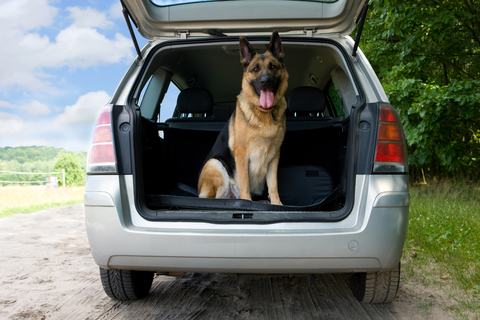An increasing number of pet owners are taking their pets with them when they travel by car or airplane rather than leaving them behind. On a day-to-day basis, there may be some places where your pet may accompany you, whether you are visiting friends, going to work, or taking the pet to the groomer, veterinarian, or day care. On the other hand, it is not always practical to take your pet with you; at these times, you may have to take your pet to a boarding kennel.
Why is confinement training necessary before travel?
If you are about to introduce your pet to an unfamiliar form of travel, it is likely to cause some degree of fear or anxiety. By training your pet to be relaxed and comfortable when confined, whether it is in a crate or by means of a seat belt or harness in a car, you can reduce its fear and anxiety. In addition, it will be safer for both you and your pet if they have already learned how to be calm and settled in the confinement area.
“If you are about to introduce your pet to an unfamiliar form of travel, it is likely to cause some degree of fear or anxiety.”
Some pets travel well in the car, but others do not. They may salivate, become restless, whine, howl, bark, pace, seek your attention or physical contact (which can be dangerous if you are the driver), and they may even vomit, urinate, or pass stools. Similarly, plane travel can be extremely stressful for some pets. You may be able to predict this in advance if you know your pet’s temperament and how it reacts to car travel or being placed in a crate. Even if you expect your pet to handle a plane ride with minimum distress, you cannot be certain how the unfamiliar location, unfamiliar handlers, separation from the owners, pressure and temperature changes, unfamiliar noises, and the presence of other animals may affect your pet. However, what you can predict and control is how your pet reacts to its travel crate.
How can I prepare my pet for travel in an airplane?
Travel requirements for pets vary between airlines and destinations. It is important to check with your airline well in advance, and if you will be traveling internationally, to also check what the importation rules are for your destination country. In most cases, pets must travel in the cargo compartment of the airplane (except for some small pets in carriers and service pets that can travel with their owners).
“Travel requirements for pets vary between airlines and destinations.”
In most cases it will be necessary for your pet to travel in an airline approved carrier; therefore, your first step is to teach your pet to relax in a small, confined area, ideally in the appropriate-sized crate. You might also desensitize your pet to sounds by using recordings of airplanes. If your pet appears to be anxious, proceed slowly, and gradually increase the noise volume and the time in the carrier. You may need to start with the crate door open, spending time near your pet while it remains in the crate, giving favored toys and treats in the crate or by placing a piece of your clothing in the crate along with the pet’s bedding.

How can I train my pet to travel safely in my car?
A pet traveling in a car should always be restrained in some way to increase safety. A leash should always be used when removing a dog from the car to avoid escape or injury. There are several ways that you can travel quietly and safely with your pet, including using a carrier or crate, a harness or seat belt, or a head halter. Any of these devices will help to ensure the safety and security of both the pet and the driver. However, while these devices can help you to calm the pet during car travel, they may initially increase anxiety if you do not take the time to train your pet to accept the restraint. Choose the device that you feel will be most appropriate for both restraining and calming your pet. If you plan to use a seat belt or harness, begin in a quiet home environment without distractions and slowly condition your pet to wear the restraint using favorite rewards. Once your pet is conditioned to the crate or restraint device, you can proceed to training and rewarding your pet while wearing the seat belt or resting in its crate in the car.
What should I do if my pet is unsettled, anxious, or vocalizes in the car?
The first step is to determine what will be the most practical way for the pet to travel in the car. Traveling in a crate or attached to a seat belt provides the greatest safety for the pet and the passengers, but the pet will first need to be conditioned to rest in its crate or wear the seat belt harness in the home.
In fact, by desensitization and counterconditioning the pet to the seat belt or crate before proceeding to the car, these devices may help to improve success and reduce anxiety in the car. Some pets may feel less anxious if they are not restrained in a crate or with a seat belt; this is only acceptable if you can ensure that there is no risk to the pet or the passengers when you drive. Some owners choose to use a dividing grid to block their pet’s access to the front of the vehicle. Another option is to have a second passenger restrain and train the pet with a leash and a head halter.

The next step is to use a desensitization and counterconditioning protocol to train your pet to gradually accept and enjoy being in the car before even turning on the engine or beginning to move. Begin this phase of training by teaching the pet to enter the car for favored treats, toys, affection, or play with the engine off. For most pets this training can begin in the garage or driveway. However, if your pet might be less anxious about entering the car in a different location (e.g., at a friend’s home or at the park) you can begin training in these areas. If you will be using a crate or seat belt for confinement or restraint, then, with the car stationary and the engine off, proceed to place the pet in the crate or seat belt while giving favored treats, toys, or affection. Once the pet will settle and calm with the engine off, the desensitization and counterconditioning program can proceed to the next step, which is turning on the engine while offering the favored rewards.
“By desensitization and counterconditioning the pet to the seat belt or crate before proceeding to the car, these devices may help to improve success and reduce anxiety in the car.”
In some cases, a leash and head halter might be a more practical means to get the pet to settle and calm in the car, with or without the use of a crate or seat belt. Or, you may choose to begin desensitization and counterconditioning with the head halter, seat belt, or crate in the home while playing a recording of a car engine. When you can train your pet to relax and take rewards in the car with the engine running, gradually increase the time the pet remains relaxed in the car before giving the rewards. Your next steps are engaging the car into gear, briefly moving back or forth in the driveway, and slowly increasing the length of the drive. With some pets, you may be able to proceed to short drives much quicker if you utilize a head halter and consistently and repeatedly take your pet to one of its favored destinations such as the park or to visit a family member. When you begin, avoid trips that are too long or result in an outcome that is unpleasant to your pet (such as a groomer or veterinary visit).
Make sure you do not reinforce attention seeking or anxious behaviors by giving attention; only reinforce your pet when it is relaxed and settled. This requires ignoring your pet until it settles, using commands that achieve settled behaviors, or using a leash and head halter to more quickly settle the pet. Settled behaviors should then earn the most desired reward (treats, toys, or your attention).
What can I do if I do not have time to train my pet?
It is always better to train your pet prior to any travel; however, in most cases this is not practical. A new pet is usually brought home in a car and requires further travel when you make trips to the veterinarian or training classes. Fortunately, most young pets will quickly adapt to these situations if the outcome of the trip is enjoyable and if you ignore attention seeking or anxious behavior while reinforcing calm or relaxed behavior. This is most easily accomplished if you have your pet wear a head halter or confine it to a carrier or crate.
What else can I use to make my pet less stressed while traveling?
You can reduce stress associated with new situations by using a familiar crate and bedding and favorite toys. For dogs, you can try using dog appeasing pheromone (Adaptil) spray in the kennel or try placing an Adaptil collar on your dog. For cats, you can use Feliway spray. These may help reduce your pet’s anxiety and fear. One study found that aromatherapy might also aid in calming the pet. Other natural alternatives have also been suggested, but unless there is data to support their efficacy, anecdotal recommendations should not be considered reliable.
Can I use sedatives or other medication for my pet for car and air travel?
This is certainly an option if your pet cannot relax during travel and may injure or harm itself. However, you should talk to your veterinarian first to assess your pet’s health and consider a medication trial at home or in the veterinary hospital before actually traveling.
“Trial dosing to determine the correct drug dose and its duration of effect is best accomplished before the actual date of the trip.”
The correct dose and duration of effects of sedatives vary greatly between individuals, and some pets actually become more agitated or anxious with these drugs. Therefore, trial dosing to determine the correct drug dose and its duration of effect is best accomplished before the actual date of the trip.
For some pets, drugs such as antidepressants may be helpful over the long term, but antidepressants need to be given for several weeks to achieve optimum effect. This treatment is most practical if you are planning a long trip or an extended vacation with your pet. Sedatives are another option for some pets, since they can reduce nausea and may help your pet to sleep through the trip. However, these drugs do not reduce anxiety and can reduce blood pressure and the ability to regulate body temperature. While they might be useful and effective for car rides in healthy pets, they are generally not indicated for most pets for airline travel.
© Copyright 2013 LifeLearn Inc. Used and/or modified with permission under license.






